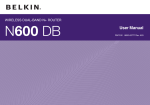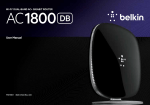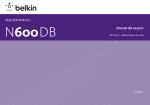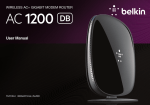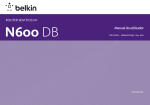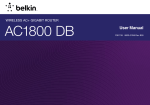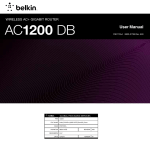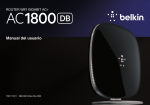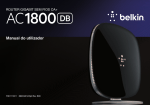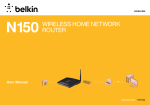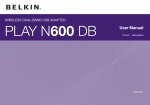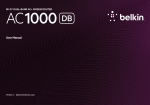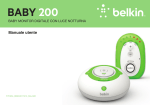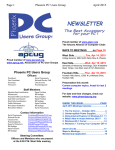Download N600DB - Belkin
Transcript
Wireless N+ ROUTER N600 DB User Manual F9K1102V3 8820xx01233xx Rev. A00 English Table Of Contents Getting Started . . . . . . . . . . . . . . . . . . . . . . . . . . . . . . . . . . . . . . . . . . . . 1 USING YOUR ROUTER . . . . . . . . . . . . . . . . . . . . . . . . . . . . . . . . . . . . 37 What’s in the Box . . . . . . . . . . . . . . . . . . . . . . . . . . . . . . . . . . . . . . . . . . . . . 1 Initial Setup . . . . . . . . . . . . . . . . . . . . . . . . . . . . . . . . . . . . . . . . . . . . . . . . . . 1 How to Set It Up . . . . . . . . . . . . . . . . . . . . . . . . . . . . . . . . . . . . . . . . . . . . . . 2 Connect Your Wireless Devices . . . . . . . . . . . . . . . . . . . . . . . . . . . . . . . . 20 Enabling Auto Update on Your Belkin Router . . . . . . . . . . . . . . . . . . . . . Updating the Router’s Firmware via the Web Interface . . . . . . . . . . . . . Resetting the Router . . . . . . . . . . . . . . . . . . . . . . . . . . . . . . . . . . . . . . . . . . Restoring Your Router to Factory Defaults . . . . . . . . . . . . . . . . . . . . . . . Restoring the Router to Default Settings Using the Web Interface . . . ADDITIONAL CAPABILITIES . . . . . . . . . . . . . . . . . . . . . . . . . . . . . . . 22 Adding USB Devices . . . . . . . . . . . . . . . . . . . . . . . . . . . . . . . . . . . . . . . . . 22 Bundled Software . . . . . . . . . . . . . . . . . . . . . . . . . . . . . . . . . . . . . . . . . . . . 25 37 39 42 42 43 Troubleshooting, Support, and Warranty . . . . . . . . . . . . . . . . . . . . 45 Belkin International, Inc., Limited 2-Year Product Warranty . . . . . . . . . 53 Getting to Know Your Router . . . . . . . . . . . . . . . . . . . . . . . . . . . . . . . 33 Regulatory and safety Information . . . . . . . . . . . . . . . . . . . . . . . . . 56 Front Panel . . . . . . . . . . . . . . . . . . . . . . . . . . . . . . . . . . . . . . . . . . . . . . . . . . 33 Back Panel . . . . . . . . . . . . . . . . . . . . . . . . . . . . . . . . . . . . . . . . . . . . . . . . . . 34 Declaration of Conformity with electromagnetic compatibility and electromagnetic interference . . . . . . . . . . . . . . . . . . . . . . . . . . . . . . . . . . 56 Europe – EU Declaration of Conformity . . . . . . . . . . . . . . . . . . . . . . . . . . 57 General Safety Information: . . . . . . . . . . . . . . . . . . . . . . . . . . . . . . . . . . . . 57 Technical Details . . . . . . . . . . . . . . . . . . . . . . . . . . . . . . . . . . . . . . . . . 35 Technical Features . . . . . . . . . . . . . . . . . . . . . . . . . . . . . . . . . . . . . . . . . . . 35 System Requirements . . . . . . . . . . . . . . . . . . . . . . . . . . . . . . . . . . . . . . . . 36 Getting Started What’s in the Box Initial Setup N600 DB Wireless N+ Router Where to Place Your Router Ethernet cable (attached to router) For the best results, place the Router next to your modem in an open location, away from large metal objects and magnets such as those found in speakers. Raising the Router above floor level can improve the strength of your wireless signal. Power supply (attached to router) Network information card (attached to router) Quick Setup Guide 1 Getting Started How to Set It Up Connect Your N600 DB Router Turn off your modem by disconnecting its power supply. Some modems have a battery backup; this will need to be disconnected at this time as well. Connect your Router to your modem using the cable (already attached). Power up your modem by plugging in its power supply. If your modem has a battery backup, it can be reconnected at this time; you may need to hold the reset button for 10 seconds. Power up your Router by plugging in its power supply. 2 Getting Started Connect to Your Router Retrieve the network ID card from the foot of your new Belkin Router. When requested, please enter the password (security key) provided on the card. When your device has connected to the Router, use a browser to visit http://router/. The router homepage will appear. Can’t find the card? The default network name and password are also printed on the foot of the Router. Use your computer, tablet, or smartphone to connect to the wireless network shown on the network ID card. For information on how to connect your wireless devices, please see the “Connect Your Wireless Devices” section on page 20. 3 Getting Started If the page does not load, then try visiting http://192.168.2.1 to see the router homepage. Click the “Detect my connection” button in green. (If you would rather set up the Router manually, click the “set it up manually” link and proceed to page 11.) After several moments, your Router should automatically detect your Internet connection and restart. This can take anywhere from 30 seconds to 3 minutes depending on your connection type. If your Router is unable to establish an Internet connection on its own, you may be asked to restart your modem or provide a username and password if your connection requires one. Follow the on-screen instructions provided. 4 Getting Started Once your Router is online, it will determine if there is a firmware update available and offer to install it. Please allow up to 5 minutes for the firmware to update. 5 Getting Started If there are no updates available, then setup will proceed. 6 Getting Started At the next screen you will be invited to change your network name and password. Re-using your previous network name (SSID) and password makes connecting your existing devices to the new router much easier. If you changed your network name and password, make note of it on the service card located on the foot of the Router. You will then have to connect to the new network. If you decide to change these settings, then enter the new values and click “Save and Continue.” (Note: The password must be at least 8 characters long.) 7 Getting Started Please take this opportunity to register your Router. This will help technical support if there is a problem with your Router. Simply complete each of the required fields and click “Complete Registration.” If you don’t want to register right now, click “Register Later” to proceed. 8 Getting Started At the next screen you can download optional software that was bundled with your Router. When finished installing optional software, click “Thanks, take me to the dashboard.” This screen shows you optional software that is available for your Router, such as the USB software to allow you to print through the Router’s USB port. If you wish to download and install any of these software programs, simply click on the button appropriate for your device. Congratulations! You are now at your Router’s dashboard. Your Router is set up and ready to use. 9 Getting Started Using the WPS Button 1.Start WPS Push Button Connection (WPS PBC) on your computer or other Wi-Fi device that you would like to connect wirelessly to your Router. Often there will be a button for this purpose in software that came with the device, or a physical “WPS,” “PBC,” or “Security” button on the device itself. 2.Within two minutes, press the WPS button on your Router. The WPS light (small light above WPS button) will blink blue while it listens for your Wi-Fi device. Once a connection is established, the light will turn blue and then go out. If a connection is not established, the light will blink amber. You may repeat the process to try again. You can repeat this process for each WPS-enabled device you’d like to add to your network. 10 Getting Started Manually Set Up Your Internet Connection Use a browser to visit http://router/. You can also try visiting http://192.168.2.1/. The Router’s Welcome page should appear. Click the “Set it up manually” link. Please select the type of connection your ISP provides. Refer to page 16 for a description of the connection types. If the selected connection type requires additional information (such as an ISP username and password), the system will ask you for it. At the next screen you will be invited to change your network name and password. Reusing your previous network name (SSID) and password makes connecting your existing devices to the new router much easier. 11 Getting Started If you decide to change these settings, then enter the new values and click “Save and Continue.” (Note: The password must be at least 8 characters long.) Click “Great, what’s next?” If you changed your network name and password, make note of it on the service card located on the foot of the Router. You will then have to connect to the new network. Please refer to page 20 to do this. 12 Getting Started Please take this opportunity to register your Router. This will help technical support if there is a problem with your Router. This screen shows you optional software that is available for your Router, such as the USB software to allow you to print through the Router’s USB port. If you wish to download and install any of these software programs, simply click on the button appropriate for your device. Simply complete each of the required fields and click “Complete Registration.” If you don’t want to register right now, click “Register Later” to proceed. When finished installing optional software, click “Thanks, take me to the dashboard.” At the next screen you can download optional software that was bundled with your Router. 13 Getting Started Congratulations! You are now at your Router’s dashboard. Your Router is now set up and ready to use. The status of your Internet connection is shown in the upper left corner of the Router’s homepage. If it does not say “Online,” troubleshooting information will be displayed. 14 Getting Started Manually Configuring Your Router’s Internet from the Dashboard To set up your ISP connection manually, select “Connection Type” from the list under the header Internet WAN. 15 Getting Started Dynamic Connection Cable and fiber customers generally require a dynamic connection. Some DSL customers require a PPPoE connection. Let’s try dynamic first. Select “Dynamic” from the menu that appears and press “Next.” 16 Getting Started If after a few minutes your Internet Status says “Online,” you’re done! You can surf the Internet. A host name is generally not required. Hit “Save.” The Router will restart. If these steps do not work, try restarting your modem and repeating the process. If not, we’ll try a PPPoE connection next. 17 Getting Started PPPoE Connection Some DSL customers require a PPPoE connection. Select PPPoE this time and press “Next.” 18 Getting Started Enter the username and password supplied by your Internet provider and click “Save.” Ignore the other fields unless required by your ISP. The Router will restart. If after a few minutes your Internet Status says “Connected,” you’re done! You can surf the Internet. If these steps do not work, try restarting your modem and repeating the process. 19 Getting Started Connect Your Wireless Devices Android™ (phones and tablets) iOS 1. Open the Settings app and select Wireless and Network. (iPhone, iPad, and iPod touch) 2. From there, select Wi-Fi to see the list of available networks. 1. Open the Settings app and select the Wi-Fi menu item. 3. Select your wireless network from the list. If asked to do so, enter your network password. 2. Select your wireless network from the list that appears there. If asked to do so, enter the network password. Mac OS ® X Your Mac® provides a menu of available wireless networks at the right end of the menu bar. 1. Click on the icon showing wireless waves. 2. Select your wireless network from the list that appears there. If asked to do so, enter the network password. 20 Getting Started Windows® 7 Your computer provides a menu of available wireless networks at the right end of the task bar. 1. Left-click on the icon that looks like signal strength bars. 2. Select your wireless network from the list. If asked, enter your network password (network key). Windows Vista ® and Windows XP Your device provides a menu of available wireless networks at the right end of the task bar. 1. Right-click on the icon that shows a computer with wireless waves (XP) or two computers (Windows Vista). 2. Choose “View Available Wireless Networks (XP)” or “Connect to a network (Vista)” from the menu. 3. Select your wireless network from the list. If asked, enter your network password (network key). 21 ADDITIONAL CAPABILITIES Adding USB Devices 22 Additional Capabilities Adding a Drive Adding a Printer You can share a USB hard drive or flash drive to your network via your Router’s USB port. Once connected, you can share files and music with other computers and devices within your network. You can add a printer to your network via your Router’s USB port. Once connected, you can print from various computers and wireless devices within your network. Plug your USB hard drive into the USB port on the back of your Router. Plug your printer’s USB cable into the USB port located on the back of your Router. You can manually check the status of your shared drive by visiting the USB Print and Storage Manager. If you have difficulty sharing a drive on your network, please see the “Troubleshooting” section of this manual. You can manually check the status of your printer by visiting the USB Print and Storage Manager, found under the Belkin icon displayed in your system tray (Windows) or menu bar (Mac). If you have difficulty sharing a printer on your network, please see the “Troubleshooting” section of this manual. A few USB hard disks require more power than the Router’s USB port provides. In these cases, you may notice the drive failing to come on or remaining on for a short time. If your disk has an optional power supply, please use it while the disk is attached to your Router. Note: Each computer that will use the printer must have both the Belkin software and the printer’s driver installed. If the print driver is not installed, you will be asked to install it by the Belkin USB Print and Storage Manager. 23 Additional Capabilities Adding Other USB Devices Other USB devices may also be shared via your Router. Plug your device into the USB port located on the back of your Router. Computers running the Belkin USB Print and Storage Manager will be able to make use of the shared device. 24 Additional Capabilities Bundled Software USB Print and Storage Manager The USB Print and Storage Manager helps to manage and monitor the use of your USB printers, scanners, hard drives, and other devices that are connected to your Router’s USB port and shared across your network. 25 Additional Capabilities Guest Access You can allow guests to use your Internet connection without joining your personal network. The network name and password for the guest network is located on the network information card found under the foot of your Router. A person using your guest network will be able to join without a password, but will be shown a login page when they attempt to surf the Web. They will need to enter the guest password into this page to continue. 26 Additional Capabilities Media Server by myTwonky Media Server by myTwonky lets your Router stream music, movies, and photos to different DLNA/UPnP devices on your network. In order to use Media Server by myTwonky, you will need to insert a USB storage device with media content into a free USB port on the back of your Router. Your Router will begin to make your content available to other devices on your network automatically. If you want to configure Media Server by myTwonky, visit http://router/ and choose “Media Server.” There are several settings in the configuration page: DLNA Server: Enables or disables your media server Server Name: The name under which other devices will see your content Refresh: Re-scans your USB storage devices for media content Shared Drives: S hows information about and status of each of your attached drives. You can see the name of the drive, its capacity, and whether media is being served from it or not. When you click “Save,” your Router will save your changes. 27 Additional Capabilities There are four different filtering options: 1.Block malicious, adult, and other non-family-friendly sites 2.Block malicious and adult sites 3.Block malicious sites 4.No filters If you think a site should be added to the filtering list, submit a request at safeweb.norton.com. Content filtering may not work as intended if: 1.You are connecting through a VPN router. 2.You are routing traffic through a proxy server. 3.You have previously visited the site and it has been stored in your cache. Website Filters. Powered by Norton 4.You manually set the DNS servers on your computer, tablet, or smartphone. Web filters provide a first layer of whole-home Internet protection to guard you from unsafe and inappropriate websites on any device on your network. 28 Additional Capabilities Intellistream QoS Once complete you will see the results. Intellistream prioritizes video and gaming traffic for a better online entertainment experience. There are two ways to enable Intellistream: Run a Speed Test: In order for Intellistream to provide you the best media experience, your Router needs to know what your approximate Internet speeds are. Click “Run a Speed Test” and the test will begin. 29 Additional Capabilities If your Internet speed is greater than 70Mbps when downloading, Intellistream QoS will only improve your uploading experience. Refresh – This will retest your Internet speed. When you click “Save,” your Router will save your changes. 30 Additional Capabilities Manual set – This will let you set your approximate Internet speeds. If you do not know your Internet speeds, contact your ISP. When you click “Save,” your Router will save your changes. Intellistream is now enabled. 31 Additional Capabilities IPv6 Configuration A new version of Internet Protocol (IP) uses a 128-bit address to implement additional features that are not present in current IP addresses. Contact your ISP to inquire about their support for IPv6. Pass-Through Devices connected to your Router can talk to each other using native IPv6 packets, but information will be sent to all connected devices. Pass-through is not efficient and is not recommended for consistent use. 32 Getting to Know Your Router Front Panel B) Wi-Fi Protected Setup (WPS) Light and Button A The WPS button on the front of your Router can be used to help establish a secure connection between your Router and other WPS-enabled Wi-Fi devices such as computers. To use the WPS feature on your Router, see “Getting Started > Adding Computers to Your Network > Using the WPS Button”. B The small light near the WPS button shows what is happening while you are using WPS to establish a connection. Off: Idle Blinking Blue: The Router is listening for a WPSenabled computer or other device. Solid Blue: The Router has made a secure connection with the computer or other device. A) Router Status Light Your Router’s status is shown by the light on the front. Amber: A connection was not created. Off: The Router is not plugged into a power source. Blinking Blue: The Router is starting up. Solid Blue: The Router is connected to the Internet. Solid Amber: The modem is detected but the router is not connected to the internet Blinking Amber: The Router can’t detect the modem. Either the modem is off, is not plugged into the Router, or is unresponsive. 33 Getting to Know Your Router Back Panel A B A) Modem (WAN) Connector C) USB Port D) Reset Button Connect your modem to this port using an Ethernet cable. USB printers, disks, and other USB devices plugged into this port will be shared on your network. Each USB port has a light that indicates its status. Off: No USB device is connected or the attached USB device is not in use. This button is used to restart your Router in rare cases when it functions incorrectly. Resetting the Router will preserve your settings. This button may also be used to restore the factory default settings. Please see the Troubleshooting section for more information. Blinking: Please wait to unplug the device until the light turns off. E) Power Connector B) Wired (LAN) Connectors Connect computers and other wired network devices to these ports using Ethernet cables. C D E On: The USB device is connected and being shared on your network. 34 Connect the included power supply to this jack. Technical Details Technical Features Universal Plug-and-Play (UPnP) Compatibility The UPnP (Universal Plug-and-Play) feature in your Router offers seamless operation of voice and video messaging, games, and other applications that are UPnP-compliant. Integrated 802.11n Wireless Access Point Utilizing Dual-Band Network technology, your Router creates two separate networks (one at 2.4GHz band and the other at 5GHz band), allowing increased bandwidth to all your connected wireless devices and computers. Web-Based Advanced User Interface You can easily make changes to your Router’s advanced settings through your web browser. These changes can be made from any computer on your network. NAT IP Address Sharing To save you the cost of adding IP addresses per computer in your house, your Belkin Router uses Network Address Translation (NAT) technology, allowing you to share a single IP address across your network. Belkin Router Monitor The Belkin Router Monitor application helps you to monitor your Router’s status and change network settings. Integrated 4-Port 10/100 Switch Your Router has a built-in, 4-port network switch to allow your wired computers to share: printers, data, MP3 files, digital photos, and much more. SPI Firewall Your Router is equipped with a firewall that will protect your network from a wide array of common attacks and viruses. USB Port The USB port lets you plug in printers, hard drives, and other USB devices to share across your network. 35 Technical Details System Requirements Setup Software Router A computer running Windows ® XP SP3 or higher, Windows Vista®, or Windows 7; or Mac OS ® X v10.5 or v10.6 only Minimum 1GHz processor and 512M BRAM Broadband Internet connection such as a cable or DSL modem with RJ45 (Ethernet) connection 600MB of free hard-drive space for installation At least one computer with an installed network interface adapter TCP/IP networking protocol installed on each computer USB Print and Storage Manager RJ45 Ethernet networking cable Windows XP SP3 or higher or Windows Vista; or Mac OS X v10.5 or v10.6 only Internet browser Minimum 1GHz processor and 512MB RAM 50MB of free hard-drive space for installation 36 USING YOUR ROUTER Enabling Auto Update on Your Belkin Router The Router has the capability to automatically check for a newer version of firmware and alert you when it’s available. You can choose to download the new version or ignore it. Auto Update is disabled by default. If you want to enable it, select “Enable” and click “Save”. Note: We recommend you use a computer that has a wired connection to the Router. Setup steps: 1.Open a web browser on the computer. 2.In the address bar of the web browser, type “http://192.168.2.1”. 3.Click on “System Settings” in the Router Links section on the dashboard. 37 using your router 4.Toward the lower-half side of the screen you will find “Auto Update Firmware Enabling.” 5.Select “Enable” by clicking the radio button and then click “Save” at the bottom of the screen. 38 using your router Updating the Router’s Firmware via the Web Interface The following steps show you how to update your Router’s firmware using its web interface. You do not need to be connected to the Internet as this interface is built into the Router itself. Setup steps: 1.Locate and download the firmware file from the Belkin support site. (Type your part number into the search box in the top right corner and look for “Firmware” in the title.) 2.Save the file to a location on your computer where you can get to it easily, such as your desktop. 3.Connect the computer to one of the four LAN ports on the Router (refer to image). 4.Open a web browser on the computer. 5.In the address bar of the web browser, type “http://router” or “http://192.168.2.1” and press “Enter” on your keyboard. 39 using your router 6.Click on “Firmware Update” toward the bottom. 7.Click the “Choose File” button toward the middle of the screen to search for the file you saved previously. Note: T he firmware version in the image above is depicted as an example. Your file name will vary depending on your model and version. 40 using your router 8. Select the firmware file by left-clicking on it and then click the “Open” button in the lower-right corner of the window. This will take you back into the Router’s interface. 9. Click the “Update” button. 10.A prompt asking, “Are you sure you want to continue with upgrading?” will appear. Click “OK”. 11.A second prompt will open telling you the Router will not respond during the upgrade and warning you not to remove the power supply from the Router. Click “OK” once more. Congratulations. The firmware has been updated successfully. 41 using your router Resetting the Router Restoring Your Router to Factory Defaults Press and hold the “Reset” button for at least 5 seconds, and then release it. The lights on the Router will momentarily flash. The “Router” light will begin to blink. When the “Router” light becomes solid again, the restore is complete. Reset Button – Red The “Reset” button is used in rare cases when the Router may function improperly. Resetting the Router will restore the Router’s normal operation while maintaining the programmed settings. You can also restore the factory default settings by using the “Reset” button. Use the restore option in instances where you may have forgotten your custom password. Resetting the Router Push and release the “Reset” button. The lights on the Router will momentarily flash. The “Router” light will begin to blink. When the “Router” light becomes solid again, the reset is complete. 42 using your router Restoring the Router to Default Settings Using the Web Interface Symptoms You need to restore the factory defaults using the web interface. This may be because the Router is not performing as expected or you wish to remove all previously configured settings. Setup steps 1.Open a web browser on the computer. 3.Click on “Restore Factory Defaults” in the left-hand column under the “Utilities” heading. 2.In the address bar of the web browser, type “http://router” or “http://192.168.2.1”. 43 using your router 4.Click on the “Restore Defaults” button. 5.A warning box will open that says, “Warning: All your settings will be lost. Are you sure you want to do this?” Click “OK”. 6.The Router will begin the restoring process. Once the restore is complete, the Router will reboot. Note: This may take several minutes. Your Router has successfully been restored to its factory settings. 44 Troubleshooting, Support, and Warranty I can’t connect to the Internet wirelessly. If the light on the front of the Router is solid blue, then your Router is connected to the Internet. You may not be connected to the Router’s wireless network. Please refer to “Adding Computers to Your Network” in this manual for instructions. If your Windows XP computer is running SP2, you will not be able to set up the Router via the wireless setup process. You will need to either update to Windows XP SP3 or complete the setup via a wired connection. 45 Troubleshooting, Support, and Warranty I can’t connect to the Internet wirelessly and my network name is not listed in Available Networks. My wireless network per formance is slow, inconsistent, suffers from weak signal, or I’m having difficulty maintaining a VPN connection. 1.Verify that your Router is on and the front-panel light shows solid blue. Wireless technology is radio-based, which means connectivity and the throughput performance between devices decreases when the distance between devices increases. Other factors that will cause signal degradation (metal is generally the worst culprit) are obstructions such as walls and metal appliances. Note also that connection speed may decrease as you move farther away from the Router. 2.If you are far from the Router, you might try moving closer to see if you might have been out of range. 3.Using a computer attached to the Router via a network cable, visit http://router/ and ensure that “Broadcast SSID” is ON. This setting is found on the “Channel and SSID” page. In order to determine if wireless issues are related to range, we suggest temporarily moving the computer within 10 feet from the Router if possible. Changing the wireless channel—Depending on local wireless traffic and interference, switching the wireless channel of your network can improve performance and reliability. See the section titled “Changing the Wireless Channel” for instructions on how to choose other channels. 46 Troubleshooting, Support, and Warranty Limiting the wireless transmit rate—Limiting the wireless transmit rate can help improve range and connection stability. Most wireless cards have the ability to limit the transmission rate. To change this property in Windows, go to the Windows Control Panel, open “Network Connections”, and double-click on your wireless card’s connection. In the properties dialog, select the “Configure” button on the “General” tab, then choose the “Advanced” tab and select the rate property. I’ve installed this new Router and some of my network clients (computers, game consoles, etc.) are now unable to connect. Your new Router came pre-configured with a network name and password, found printed on an attached card. All clients must use this network name and password to connect wirelessly to your Router. You will need to find the network settings on your client, select the network name printed on the card from the list of available networks, and enter the password when prompted to join the wireless network. Wireless client cards are usually set to automatically adjust the wireless transmit rate for you, but doing so can cause periodic disconnects when the wireless signal is too weak; as a rule, slower transmission rates are more stable. Experiment with different connection rates until you find the best one for your environment. Note that all available transmission rates should be acceptable for browsing the Internet. For more assistance, see your wireless card’s user manual. 47 Troubleshooting, Support, and Warranty 5.Click “Apply Changes” to finish. Your wireless connection is now encrypted. Each computer using your wireless network will need to use the new key. Does the Router support Wireless Protected Access (WPA) security? The Router ships with WPA/WPA2 security turned on. Windows XP and some older network hardware may require a software update to support WPA/WPA2. Note: If you are configuring the Router over a wireless connection, you will have to re-connect to the Router after changing any security settings. I am having difficulty setting up WPA security on my Router. Note: Some older networking hardware supports only WEP encryption. If your older computers cannot connect to your network, try 128-bit or 64-bit WEP, or seek software updates from their manufacturers. 1.Log in to your Router by visiting http://router/ with your web browser. Click on the “Login” button in the top right-hand corner of the screen. You will be asked to enter your password. If you have never set a password, leave the “Password” field blank and click “Submit”. 2.Click “Wireless” in the left-hand menu. Then click “Security” just below that. 3.Select the “WPA/WPA2” option. 4.Enter a password. This can be from 8–63 characters of your choice, including spaces and punctuation, OR a 64-digit hexadecimal number (using only the numbers 0–9 and letters A–F). 48 Troubleshooting, Support, and Warranty 5.Click “Apply Changes” to finish. Your wireless activity is now encrypted. Each computer using your wireless network will need to use the new key. I am having difficulty setting up Wired Equivalent Privacy (WEP) security on my Router. 1.Log in to your Router. Visit http://router/ with your web browser. Click on the “Login” button in the top right-hand corner of the screen. You will be asked to enter your password. If you have never set a password, leave the “Password” field blank and click “Submit”. Note: If you are configuring the Router over a wireless connection, you will have to re-connect to the Router after changing any security settings. 2.Click “Wireless” in the left-hand menu. Then click “Security” just below that. Note: Some older networking hardware supports only 64-bit WEP encryption. If your older computers cannot connect to your network, try 64-bit WEP. 3.Select the “128-bit WEP” option. 4.You may type in a WEP key manually, or generate one from a passphrase. Type a phrase in the “Passphrase” field and click the “Generate” button. A WEP key is composed of 26 hexadecimal digits (0–9, A–F.. For example, C3 03 0F AF 4B B2 C3 D4 4B C3 D4 EE 74 is a valid 128-bit WEP key. 49 Troubleshooting, Support, and Warranty A disk I plugged into the USB port is not showing up on my computer or in Memory Safe. A printer I plugged into the USB port is not showing up on my computer. 1.Is the light on over the USB port that the disk is plugged into? If not, try unplugging and re-plugging the disk. Please check that the USB connector is firmly plugged into the Router. 1.Is the light on over the USB port that the printer is plugged into? If not, try unplugging and re-plugging the printer. Please check that the USB connector is firmly plugged into the Router. 2.If your disk has an optional power supply, please use it while the disk is attached to your Router. 2.To print to a printer attached to the Router, your computer must have that printer’s driver installed. Please check that the driver is installed. 3.The Router supports FAT16, FAT32-, or NTFS-formatted disks. Disks in other formats will not appear in the Finder (Mac OS X) or Windows Internet Explorer. 3.The printer may not be set to auto-connect. Via the Belkin Router Manager, open the USB Print and Storage Center. Check that the printer appears in the list of available devices. View the properties of the printer, and check that “auto-connect” is selected. A disk I plugged into the USB port is not coming on or remains on only for a short time. Some drives require more power than the router’s USB port provides. If your disk has an optional power supply, please use it while the disk is attached to your Router. 50 Troubleshooting, Support, and Warranty A different sort of USB device that I plugged into the USB port is not showing up on my computer. Most USB devices other than disks and printers must be accessed via the USB Print and Storage Center. 1.Is the light on over the USB port that the device is plugged into? If not, try unplugging and re-plugging the device. Please check that the USB connector is firmly plugged into the Router. 2.Via the Belkin Router Manager, open the USB Print and Storage Center. Check that the device appears in the list of available devices. 3.Select the device and click the “Use” button. The device will be virtually connected to your computer until you choose to “Stop Using” the device, or another person requests use of the device. 51 Troubleshooting, Support, and Warranty Technical Support Country Number Internet adress AUSTRIA 0820 200766 www.belkin.com/de/networking/ BELGIUM 07 07 00 073 www.belkin.com/nl/networking/ www.belkin.com/fr/networking/ UK http://www.belkin.com/uk/support CZECH REPUBLIC 239 000 406 www.belkin.com/uk/networking/ DENMARK 701 22 403 www.belkin.com/uk/networking/ Australia http://www.belkin.com/au/support FINLAND 0972519123 www.belkin.com/uk/networking/ FRANCE 08 - 25 54 00 26 www.belkin.com/fr/networking/ GERMANY 0180 - 500 57 09 www.belkin.com/de/networking/ GREECE 00800 - 44 14 23 90 www.belkin.com/uk/networking/ HUNGARY 06 - 17 77 49 06 www.belkin.com/uk/networking/ Singapore 1800 622 1130 ICELAND 800 8534 www.belkin.com/uk/networking/ IRELAND 0818 55 50 06 www.belkin.com/uk/networking/ Europe http://www.belkin.com/uk/support ITALY 02 - 69 43 02 51 www.belkin.com/it/networking/ LUXEMBOURG 34 20 80 85 60 NETHERLANDS 0900 - 040 07 90 NORWAY 81 50 0287 www.belkin.com/uk/networking/ POLAND 00800 - 441 17 37 www.belkin.com/uk/networking/ PORTUGAL 707 200 676 www.belkin.com/uk/networking/ RUSSIA 495 580 9541 www.belkin.com/networking/ SLOVAKIA 08000 04614 www.belkin.com/networking/ SLOVENIA 0800 80510 www.belkin.com/networking/ SOUTH AFRICA 0800 - 99 15 21 www.belkin.com/uk/networking/ SPAIN 902 - 02 43 66 www.belkin.com/es/networking/ SWEDEN 07 - 71 40 04 53 www.belkin.com/uk/networking/ SWITZERLAND 08 - 48 00 02 19 www.belkin.com/de/networking/ www.belkin.com/fr/networking/ UNITED KINGDOM 0845 - 607 77 87 www.belkin.com/uk/networking/ OTHER COUNTRIES +44 - 1933 35 20 00 US http://www.belkin.com/support New Zealand http://www.belkin.com/au/support You can find technical-support information on our website, www.belkin.com, by navigating to the tech-support section. If you want to contact technical support by phone, please call the number you need from this list*: *Local rates apply. 52 www.belkin.com/uk/networking/ €0.10 per minute www.belkin.com/nl/networking/ Troubleshooting, Support, and Warranty Belkin International, Inc., Limited 2-Year Product Warranty What is not covered by this warranty? All above warranties are null and void if the Belkin product is not provided to Belkin for inspection upon Belkin’s request at the sole expense of the purchaser, or if Belkin determines that the Belkin product has been improperly installed, altered in any way, or tampered with. The Belkin Product Warranty does not protect against acts of God such as flood, lightning, earthquake, war, vandalism, theft, normal-use wear and tear, erosion, depletion, obsolescence, abuse, damage due to low voltage disturbances (i.e. brownouts or sags), non-authorized program, or system equipment modification or alteration. What this warranty covers. Belkin International, Inc. (“Belkin”) warrants to the original purchaser of this Belkin product that the product shall be free of defects in design, assembly, material, or workmanship. What the period of coverage is. Belkin warrants the Belkin product for two years. What will we do to correct problems? Product Warranty. Belkin will repair or replace, at its option, any defective product free of charge (except for shipping charges for the product). Belkin reserves the right to discontinue any of its products without notice, and disclaims any limited warranty to repair or replace any such discontinued products. In the event that Belkin is unable to repair or replace the product (for example, because it has been discontinued), Belkin will offer either a refund or a credit toward the purchase of another product from Belkin.com in an amount equal to the purchase price of the product as evidenced on the original purchase receipt as discounted by its natural use. 53 Troubleshooting, Support, and Warranty How to get service. To get service for your Belkin product you must take the following steps: 2.Your Belkin Customer Service Representative will then instruct you on how to forward your receipt and Belkin product and how to proceed with your claim. 1.Contact Belkin Tech Support at the number listed on page 52, within 15 days of the Occurrence. Be prepared to provide the following information: a. T he part number of the Belkin product. b. W here you purchased the product. c. W hen you purchased the product. d. C opy of original receipt. Belkin reserves the right to review the damaged Belkin product. All costs of shipping the Belkin product to Belkin for inspection shall be borne solely by the purchaser. If Belkin determines, in its sole discretion, that it is impractical to ship the damaged equipment to Belkin, Belkin may designate, in its sole discretion, an equipment repair facility to inspect and estimate the cost to repair such equipment. The cost, if any, of shipping the equipment to and from such repair facility and of such estimate shall be borne solely by the purchaser. Damaged equipment must remain available for inspection until the claim is finalized. Whenever claims are settled, Belkin reserves the right to be subrogated under any existing insurance policies the purchaser may have. 54 Troubleshooting, Support, and Warranty How state law relates to the warranty. THIS WARRANTY CONTAINS THE SOLE WARRANTY OF BELKIN. THERE ARE NO OTHER WARRANTIES, EXPRESSED OR, EXCEPT AS REQUIRED BY LAW, IMPLIED, INCLUDING THE IMPLIED WARRANTY OR CONDITION OF QUALITY, MERCHANTABILITY OR FITNESS FOR A PARTICULAR PURPOSE, AND SUCH IMPLIED WARRANTIES, IF ANY, ARE LIMITED IN DURATION TO THE TERM OF THIS WARRANTY. Some states do not allow limitations on how long an implied warranty lasts, so the above limitations may not apply to you. IN NO EVENT SHALL BELKIN BE LIABLE FOR INCIDENTAL, SPECIAL, DIRECT, INDIRECT, CONSEQUENTIAL OR MULTIPLE DAMAGES SUCH AS, BUT NOT LIMITED TO, LOST BUSINESS OR PROFITS ARISING OUT OF THE SALE OR USE OF ANY BELKIN PRODUCT, EVEN IF ADVISED OF THE POSSIBILITY OF SUCH DAMAGES. This warranty gives you specific legal rights, and you may also have other rights, which may vary from state to state. Some states do not allow the exclusion or limitation of incidental, consequential, or other damages, so the above limitations may not apply to you. 55 Regulatory and safety Information Declaration of Conformity with electromagnetic compatibility and electromagnetic interference CISPR 22 Interference Notice This equipment has been tested and found to comply with the limits for a Class B digital device, pursuant to the requirements of EN 55022 and EN 55024. These limits are designed to provide reasonable protection against harmful interference in a residential installation. We, Belkin International, Inc., of Schiphol-Rijk, Netherlands, declare under our sole responsibility that the device, F9K1102, complies with Directives stated in our EU declaration which can be obtained from our website given below. This equipment generates, uses, and can radiate radio frequency energy, and if not installed and used in accordance with the instructions, may cause harmful interference to radio communications. However, there is no guarantee that interference will not occur in a particular installation. If this equipment does cause harmful interference to radio or television reception, which can be determined by turning the equipment off and on, the user is encouraged to try and correct the interference by one or more of the following measures: • Reorient or relocate the receiving antenna. • Increase the distance between the equipment and the receiver. • Connect the equipment to an outlet on a circuit different from that to which the receiver is connected. • Consult the dealer or an experienced radio/TV technician for help. Caution: Exposure to Radio Frequency Radiation. This equipment complies with radiation exposure limits set forth for an uncontrolled environment. This equipment should be installed and operated with a minimum distance of 20cm between the radiator and your body Caution: Any changes or modifications not expressly approved by the party responsible for compliance could void the user’s authority to operate this equipment. This device and its antenna(s) must not be co-located or operating in conjunction with any other antenna or transmitter. 56 Regulatory and safety Information Europe – EU Declaration of Conformity This device complies with the essential requirements of the R&TTE Directive 1999/5/EC, the EMC Directive 2004/108/EC, and the low-voltage Directive 2006/95/EC. A copy of the European Union CE marking “Declaration of Conformity” may be obtained at the website: www.belkin.com/doc For information on product disposal please refer to http://environmental.belkin.com General Safety Information: • For indoor installation only • For installation with supplied power adapter only • The supplied power adapter is the product’s switch-off device. The base socket must be near the product and easily accessible. 57 © 2012 Belkin International, Inc. All rights reserved. All trade names are registered trademarks of respective manufacturers listed. iPad, iPhone, iPod touch, Mac, Mac OS, and Safari are trademarks of Apple Inc., registered in the U.S. and other countries. Windows, Windows Vista, Internet Explorer, and DirectX are either registered trademarks or trademarks of Microsoft Corporation in the United States and/or other countries. Belkin Ltd. Express Business Park Shipton Way, Rushden NN10 6GL, United Kingdom Belkin Ltd. Express Business Park Shipton Way, Rushden NN10 6GL, United Kingdom Belkin GmbH Otto-Hahn-Straße 20 85609 Aschheim Germany Belkin Iberia Avda de Barajas, 24, Edificio Gamma, 4ªpta, 28108 Alcobendas Madrid - Spain Belkin Italy & Greece Via Nino Bonnet, 4/6 Milan 20154 Italy Belkin B.V. Tupolevlaan 1 1119 NW Schiphol-Rijk, Netherlands




























































